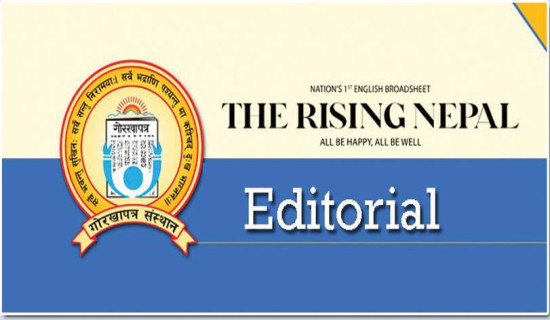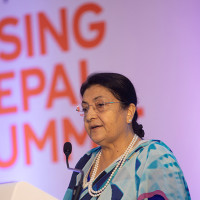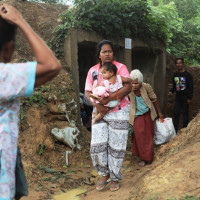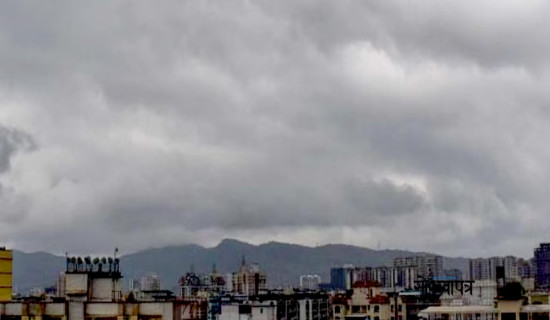- Friday, 25 July 2025
Yoga For Health, Spiritual Wellbeing
As yoga helps boost the holistic wellbeing of an individual by harmonising the body, mind, and spirit, it is becoming an important tool to manage stress, improve physical health and foster mental clarity. Numerous yoga asanas (postures) are believed to have been studied and practised by sages in the Himalayas in ancient times. Those sages had also meditated in the Himalayas for years to attain enlightenment or self-realisation. So, yoga and meditation are not new to countries like Nepal and India. Because yoga practices are instrumental in dealing with a myriad of challenges facing the frenzied contemporary life, they appear to be increasingly gaining currency among people worldwide.
Yoga sutras
Having its roots in the Vedic tradition, yoga started becoming more systematic, thanks to the efforts of the renowned sage Patanjali. In his comprehensive compilation ‘Yoga Sutras’, Patanjali defines yoga as the practice of quieting the mind. This initial text on yoga philosophy sheds light on the principles and practices of yoga. Pantanjali is revered as the ‘Father of Modern Yoga’ as he immensely contributed to the philosophy of yoga. No doubt, his ‘Yoga Sutras’ has had a wider influence. The yoga scientist is believed to have been born in Nepal during the second century BCE. However, it requires further research to justify this. Known as Ashtang yoga, his philosophy includes eight steps. They are Yama, Niyama, Asana, Pranayama, Pratyahara, Dharana, Dhyana, and Samadhi.
According to Yoga Sutras, Yama is associated with moral disciplines to be followed by people while interacting with the world. These guidelines include non-violence, truthfulness, non-stealing, continence and non-possessiveness. The second limb of Ashtang yoga is Niyama, which is related to personal disciplines. They encompass purity (Saucha), contentment (Santosha), self-discipline (Tapas), study (Swadhyaya), and devotion to god (Ishvarapranidhana). Similarly, Asana is connected to the physical postures of individuals while practicing yoga. These postures are designed in such a way that they help yoga practitioners maintain the stability of their body and mind.
Pranayama is the next step of the Ashtanga yoga. This concerns techniques to control breathing. Under these techniques, the breath is regulated and extended to influence the flow of prana (life force). Without applying proper breathing techniques, it is not possible for individuals to achieve the goal. Pratyahara is another limb. In this step, senses are withdrawn from external objects. Their awareness is directed inward. Dharana is related to concentration. Here, yoga practitioners are required to focus their mind on a particular point or object. Such concentration leads them to a meditated state.
Dhyana is the sustained practice of concentration. In this step, the mind remains fixed on the preferred object or point, especially one’s own nirakar (formless being). Samadhi (absorption) is the last stage of yoga. In this state, the individual practicing yoga is in deep immersion and union with the object of meditation. This is the climax of Ashtanga yoga where the individual consciousness unifies with the universal consciousness. Fully dedicated yoga practitioners alone can experience samadhi after the successful completion of all the steps.
The well-known Hindu scripture Bhagavad Gita highlights yoga as the journey of the self, through the self, to the self. Similarly, highlighting the significance of yoga, Deepak Chopra, an Indian-American author and new age guru, calls on people: “Amid movement and chaos, keep stillness inside of you.” Many other yoga and spiritual gurus have emphasised the need for everyone to embrace yoga practice keeping its physical, mental, emotional and spiritual benefits in mind.
Even the United Nations (UN) has given due recognition to yoga. The world marks the International Day of Yoga every year on June 21 at the call of the UN. In 2014, the 69th United Nations General Assembly (UNGA) endorsed a proposal by Indian Prime Minister Narendra Modi to declare International Day of Yoga. It is noteworthy that the proposal was first seconded by the then prime minister of Nepal, Sushil Koirala. As many as 177 countries from around the globe extended their support to the proposal in 90 days after it was put out for approval. Raising awareness worldwide about the varied benefits of practicing yoga is the main aim of this day.
It is notable that the World Health Organisation (WHO) has also appealed to its member states to help their citizens reduce physical inactivity. According to the WHO, physical inactivity is among the top ten leading causes of death globally. It is a major risk factor for non-communicable diseases like cardiovascular diseases, cancer and diabetes.
Yoga centres
Meanwhile, the International Day of Yoga was celebrated worldwide this year as well, with the theme “Yoga for One Earth, One Health”. The theme lays focus on the profound connection between personal wellness and the health of the planet. In Nepal, the day was observed with various programmes. Though the Yoga Day has been marked unofficially in Nepal since 1979 on Magh 1 (mid-January), it was not so effective. With the creation of massive public awareness about the importance of yoga, more people seem to be practicing yoga across the country. Over the past few decades, the country has seen a rapid growth in the number of yoga centres as well.
Such yoga centres have not only contributed to educating people about the physical and mental health benefits of yoga asanas but also assisted in improving the health condition of more people. All three-tier governments now seem to have started giving importance to the promotion of yoga and meditation. This is really a commendable initiative. The governments must come up with concrete policies and plans to expand yoga practices. They should also join hands with the existing yoga centres set up at the community level for the promotion of yoga.
(The author is a former deputy executive editor of this daily.)

















